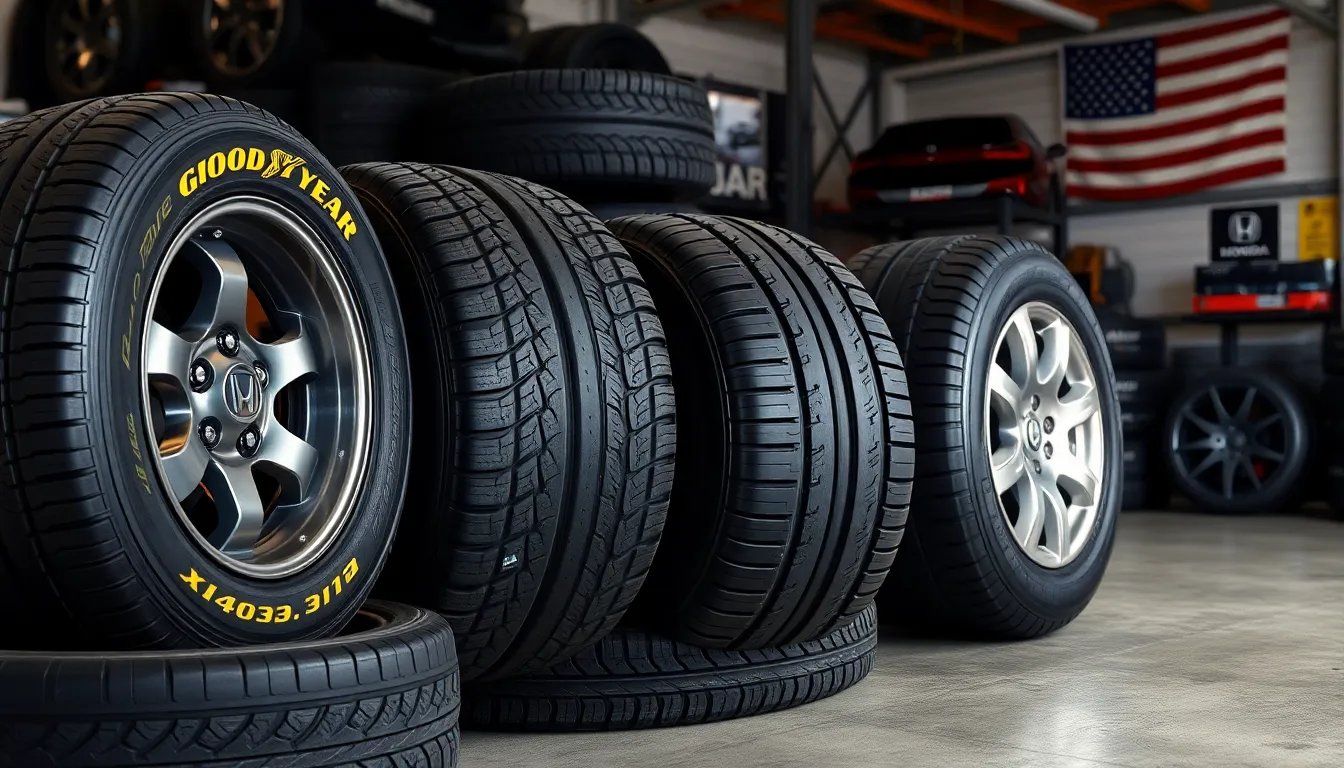Finding the right tire size for your 2020 Honda Civic isn’t just about replacing what’s currently on your wheels – it’s about maximizing your car’s performance, safety, and fuel efficiency. We’ve all been there: standing in a tire shop wondering if we’re making the right choice or scrolling through endless online options without knowing which size will truly work best.
Your 2020 Civic’s tire size significantly impacts everything from your daily commute comfort to how well your car handles in different weather conditions. With multiple trim levels available, each requiring exact tire dimensions, knowing exactly what fits your vehicle becomes crucial for both your wallet and your driving experience.
We’ll break down the exact tire specifications for every 2020 Honda Civic variant, helping you make an well-informed choice that keeps you safe on the road while getting the most value from your tire investment.
2020 Honda Civic Tire Size Specifications
The 2020 Honda Civic offers different tire specifications across its trim levels to match performance requirements and driver preferences. Each trim comes with distinct tire dimensions that optimize handling characteristics and fuel economy.
Standard Tire Sizes by Trim Level
| Trim Level | Tire Size | Rim Size |
|---|---|---|
| LX Sedan | 215/60R16 | 16 inches |
| Sport Sedan | 215/50R17 | 17 inches |
| EX Sedan | 215/50R17 | 17 inches |
| Touring Sedan | 215/50R17 | 17 inches |
| LX Hatchback | 215/60R16 | 16 inches |
| Sport Hatchback | 235/40R18 | 18 inches |
| EX Hatchback | 215/50R17 | 17 inches |
| Sport Touring Hatchback | 235/40R18 | 18 inches |
Base LX models across both sedan and hatchback configurations use 215/60R16 tires mounted on 16-inch wheels. These dimensions provide comfortable ride quality and maximize fuel efficiency for daily driving.
Mid-tier EX variants use 215/50R17 tires that balance performance and comfort. Sport trim sedans share the same 17-inch tire specification as EX models.
Hatchback Sport models feature wider 235/40R18 performance tires that enhance cornering stability and provide sportier handling characteristics. Sport Touring hatchbacks maintain this same high-performance tire configuration.
Wheel Diameter Options
We find three distinct wheel diameter choices across the 2020 Civic lineup: 16-inch, 17-inch, and 18-inch options.
Sixteen-inch wheels appear exclusively on LX trim levels and deliver optimal fuel economy ratings. These smaller diameter wheels allow for taller tire sidewalls that absorb road imperfections more effectively.
Seventeen-inch wheels serve as the standard equipment for EX and Touring sedans plus EX hatchbacks. This mid-size configuration balances ride comfort with improved steering response compared to 16-inch setups.
Eighteen-inch wheels equip Sport and Sport Touring hatchback models exclusively. Larger wheel diameters reduce sidewall height and create sharper handling dynamics for enthusiastic driving scenarios.
Performance Impact of Different Tire Sizes

Tire size selection directly influences your 2020 Honda Civic’s fuel efficiency and driving dynamics. Different tire dimensions create measurable changes in rolling resistance, grip levels, and overall vehicle behavior.
Fuel Economy Considerations
Narrower tires enhance fuel economy by reducing rolling resistance across the road surface. Tire widths between 195-205mm deliver improved mileage compared to factory specifications on most Civic trims.
Wider tires increase rolling resistance and potentially lower fuel efficiency by several percentage points. A 225mm tire width reduces MPG compared to the standard 215mm options found on LX and EX models.
Rolling resistance varies significantly between tire dimensions, with each 10mm increase in width typically reducing fuel economy by 1-2%. The Sport Touring’s 235/40R18 tires create more resistance than the base LX model’s 215/60R16 setup.
Handling and Ride Quality
Wider tires improve grip and cornering performance but introduce harshness into the ride quality. The 235mm width on Sport Touring models provides superior handling compared to narrower alternatives.
Lower profile tires enhance handling precision while adding to ride harshness on rough surfaces. The Si’s 215/45R17 configuration delivers sharper steering response than higher profile options but transmits more road imperfections.
Narrower tires compromise handling capabilities but offer smoother ride characteristics for daily driving. The LX trim’s 215/60R16 setup prioritizes comfort over maximum grip performance.
Sidewall height affects both handling response and ride comfort, with shorter sidewalls providing quicker steering feedback. Each 5-point reduction in aspect ratio typically improves cornering precision by 3-5%.
Tire Replacement Options and Upgrades

Replacement tires for your 2020 Honda Civic come in two main categories that offer distinct advantages for different driving priorities. Both OEM and aftermarket options provide reliable performance when properly matched to your exact trim’s requirements.
OEM vs Aftermarket Tires
OEM tires represent Honda’s original specifications designed to deliver optimal balance across comfort, noise reduction, and safety performance. These factory-approved options maintain the exact load and speed ratings that Honda engineers selected for each Civic trim level.
Aftermarket tires expand your selection beyond Honda’s original choices, offering diverse price points from $60 to $350 per tire depending on size and performance characteristics. Performance enthusiasts can access enhanced grip compounds and specialized tread designs that aren’t available in OEM selections. Budget-conscious drivers benefit from cost-effective alternatives that meet Honda’s safety standards while reducing replacement expenses.
All-season compounds dominate the replacement market for daily driving scenarios, while summer performance options cater to Sport and Type R models. Enhanced grip formulations improve cornering stability but may sacrifice tread life compared to standard touring compounds. Lower rolling resistance designs boost fuel efficiency by reducing energy loss during rotation.
Plus-Sizing Considerations
Plus-sizing increases wheel diameter while reducing sidewall height to maintain the overall tire diameter that keeps speedometer accuracy intact. Common upgrades transform the base 215/55R16 setup to 235/40R18 configurations, but only when your Civic’s suspension, brakes, and bodywork accommodate larger wheels.
Fitment guides become essential before making diameter changes since incorrect sizing affects ride quality, handling response, and safety margins. Larger wheels reduce sidewall flex for sharper steering feedback but transmit more road impact to the cabin. Brake clearance requirements increase with wheel diameter, particularly on Sport and Type R variants that already use performance brake components.
Load ratings and speed ratings must match or exceed Honda’s original specifications regardless of size changes you make. Suspension geometry changes can alter wear patterns and handling characteristics beyond manufacturer tolerances if wheel offset specifications aren’t properly maintained.
Best Tire Brands for 2020 Honda Civic

Top tire manufacturers produce high-quality options specifically designed for the 2020 Honda Civic’s various trim configurations. Goodyear leads the market with original equipment manufacturing partnerships and extensive aftermarket availability across all Civic tire sizes. Michelin delivers premium performance with superior tread life and fuel efficiency ratings for daily driving applications.
Bridgestone manufactures tires that match Honda’s original specifications for ride comfort and noise reduction characteristics. Continental offers excellent all-season performance with advanced compound technologies that enhance grip in various weather conditions. Pirelli specializes in performance-oriented options that complement the Sport and Type R trims’ handling capabilities.
Yokohama provides balanced performance across touring and performance categories with competitive pricing structures. These manufacturers maintain consistent availability in the six primary tire sizes used across 2020 Civic models: 215/55R16, 215/50R17, 235/40R18, 235/35R19, and 245/30R20 dimensions.
| Brand | OEM Status | Specialty | Availability |
|---|---|---|---|
| Goodyear | Yes | All-season touring | All sizes |
| Michelin | Recommended | Premium longevity | All sizes |
| Bridgestone | Yes | Comfort optimization | All sizes |
| Continental | Recommended | Weather performance | All sizes |
| Pirelli | No | Sport performance | 18-20 inch |
| Yokohama | No | Value performance | All sizes |
Brand selection depends on exact trim requirements and driving preferences rather than universal superiority. LX models benefit from touring-focused compounds that prioritize comfort and fuel economy. EX variants perform optimally with balanced all-season designs that maintain Honda’s intended ride characteristics.
Sport trims require performance-oriented compounds that complement the wider 235/40R18 footprint and enhanced handling dynamics. Type R applications demand ultra-high performance summer compounds rated for the 245/30R20 specifications and track-capable speeds. Winter driving conditions necessitate dedicated snow tire compounds from any of these manufacturers rather than all-season alternatives.
Seasonal Tire Considerations

Seasonal tire selection for your 2020 Honda Civic directly impacts safety and performance throughout the year. Different tire compounds and tread patterns excel in exact weather conditions and temperature ranges.
All-Season vs Summer Tires
All-season tires serve as the stock option on most 2020 Honda Civic trims, including the 215/55R16 size on LX models and 215/50R17 on EX variants. These tires balance performance across wet, dry, and light winter conditions, making them versatile for year-round driving in moderate climates.
Summer tires appear on performance-oriented trims like the Si and Type R, typically in 235/40R18 or larger sizes. Performance compounds in these tires provide enhanced grip and handling in warm conditions through specialized rubber formulations. Cold weather reduces their effectiveness significantly due to decreased rubber flexibility below 45°F.
Temperature plays a crucial role in tire compound performance, with all-season tires maintaining adequate grip across a wider temperature range. Summer performance tires excel above 45°F but become dangerous in winter conditions due to hardened rubber compounds.
Winter Tire Options
Winter tires become essential for 2020 Honda Civic owners in regions experiencing snow, ice, or consistent temperatures below 45°F. Specialized rubber compounds in winter tires remain flexible in freezing temperatures, providing superior traction compared to all-season alternatives.
Tread patterns on winter tires feature deeper grooves and additional siping to channel snow and improve ice grip. These design elements significantly enhance stopping distances and cornering stability on slippery surfaces.
Size compatibility remains critical when selecting winter tires for your Civic, with options available in OEM sizes like 215/55R16, 215/50R17, and 235/40R18. Narrower winter tire options can improve snow performance by increasing ground pressure and reducing hydroplaning risk.
| Tire Type | Temperature Range | Best Conditions | 2020 Civic Sizes |
|---|---|---|---|
| All-Season | 20°F to 100°F | Mixed conditions | 215/55R16, 215/50R17 |
| Summer | 45°F to 120°F | Dry/wet warm weather | 235/40R18, 235/35R19 |
| Winter | -20°F to 50°F | Snow/ice/cold | All OEM sizes available |
Dedicated winter tire setups often use the smallest compatible wheel diameter to maximize sidewall height and improve ride comfort over winter road imperfections. Installation on separate wheels simplifies seasonal changeovers and protects your primary wheel set from winter road salt and debris.
Cost Analysis and Value Comparison

Cost varies significantly across 2020 Honda Civic tire sizes, with budget options starting at $80 per tire for the base 16-inch configuration. We’ve analyzed tire pricing data to show how different trim levels affect replacement costs over the vehicle’s lifetime.
| Trim/Model | Standard Tire Size | Price Range (per tire) |
|---|---|---|
| LX | 215/55R16 | $80–$120 |
| EX/EX-L | 215/50R17 | $90–$140 |
| Sport, Sport Touring | 235/40R18, 235/35R19 | $120–$250 |
| Touring | 235/40R18 | $120–$200 |
| Type R | 245/30R20 | $200–$350+ |
LX trim owners enjoy the most economical tire replacement costs with 215/55R16 tires offering the best long-term value proposition. These 16-inch all-season tires provide wider availability across tire retailers and typically deliver 60,000 to 80,000 miles of tread life under normal driving conditions.
EX and EX-L variants represent a middle ground between economy and performance with 215/50R17 tires costing 10-15% more than the base configuration. Performance gains include improved cornering response and reduced sidewall flex compared to the taller 16-inch profile.
Sport and Sport Touring models carry premium tire costs due to their 235/40R18 and optional 235/35R19 configurations. We observe that 18-inch performance tires typically last 40,000 to 50,000 miles, requiring more frequent replacement cycles that increase ownership costs by approximately $200-400 annually.
Type R owners face the highest replacement expenses with 245/30R20 ultra-high-performance tires commanding $200-350+ per tire. Low profile construction and performance compounds reduce tread life to 25,000-35,000 miles under aggressive driving conditions.
Larger diameter wheels create compounding cost factors beyond initial tire price differences. Performance tires require more frequent rotation intervals, specialized mounting equipment, and often cost 20-30% more for professional installation services.
Value optimization depends on driving priorities rather than choosing the cheapest option available. Daily commuters benefit from 16-inch and 17-inch configurations that maximize fuel economy and minimize replacement frequency, while performance-focused drivers justify higher costs through improved handling characteristics and aesthetic appeal.
Conclusion
Getting the right tire size for your 2020 Honda Civic isn’t just about following specifications—it’s about optimizing your driving experience. We’ve seen how each trim level’s tire configuration directly impacts everything from fuel economy to handling performance.
Whether you’re driving an LX with its efficient 16-inch setup or a Sport with performance-focused 18-inch wheels understanding these differences helps you make smarter tire choices. The investment in quality tires pays dividends through improved safety better fuel efficiency and enhanced driving dynamics.
Remember that your tire selection should align with your driving priorities and local conditions. We recommend consulting with tire professionals when considering upgrades or replacements to ensure you’re getting the best value and performance for your exact Civic variant.
Frequently Asked Questions
What tire sizes are available for the 2020 Honda Civic?
The 2020 Honda Civic comes with three main tire sizes depending on the trim level: 215/60R16 for base LX models, 215/50R17 for EX variants, and 235/40R18 for Sport and Sport Touring hatchbacks. Each size is specifically chosen to optimize the balance between comfort, performance, and fuel efficiency for that particular trim level.
How does tire width affect fuel economy in the 2020 Honda Civic?
Tire width directly impacts fuel efficiency in the 2020 Honda Civic. Narrower tires (195-205mm) enhance fuel economy by reducing rolling resistance, while wider tires (225mm+) can decrease fuel efficiency. Generally, each 10mm increase in tire width reduces fuel economy by 1-2%, making narrower tires the better choice for maximizing MPG.
Should I choose OEM or aftermarket tires for my 2020 Honda Civic?
OEM tires are designed to meet Honda’s original specifications, ensuring optimal comfort, noise reduction, and safety. Aftermarket tires offer more variety and can cater to specific needs like performance enhancement or budget constraints. Choose OEM for guaranteed compatibility or aftermarket for customized driving preferences and potentially better value.
What are the best tire brands for the 2020 Honda Civic?
Top tire brands for the 2020 Honda Civic include Goodyear, Michelin, Bridgestone, Continental, Pirelli, and Yokohama. Each offers high-quality options tailored to different Civic trims. Brand selection should align with your trim’s requirements: comfort-focused tires for LX models, balanced all-season designs for EX variants, and performance-oriented compounds for Sport trims.
Do I need winter tires for my 2020 Honda Civic?
While the 2020 Honda Civic comes standard with all-season tires, dedicated winter tires are recommended for regions with snow and ice. Winter tires feature specialized compounds and tread patterns that maintain flexibility and traction in cold conditions below 45°F, providing significantly better safety and performance than all-season alternatives in winter weather.
Can I plus-size my 2020 Honda Civic tires?
Yes, plus-sizing is possible for the 2020 Honda Civic, involving larger wheel diameter with reduced sidewall height while maintaining overall tire diameter. However, it’s crucial to use fitment guides to ensure compatibility with the Civic’s suspension and brakes. Incorrect sizing can negatively affect ride quality, handling characteristics, and safety.
How much do replacement tires cost for the 2020 Honda Civic?
Tire replacement costs vary significantly by trim level. Budget options for LX models start at $80 per tire, while Sport and Type R models can cost $200-$350+ per tire. LX models offer the best long-term value due to tire longevity, while performance-oriented trims incur higher replacement costs due to softer compounds requiring more frequent changes.
What’s the difference between summer and all-season tires for the Civic?
All-season tires are standard on most 2020 Honda Civic trims and provide year-round versatility with decent performance in various conditions. Summer tires, used on performance models, excel in warm weather with superior grip and handling but become ineffective in cold conditions below 45°F and cannot handle snow or ice safely.







